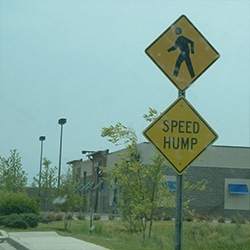What is the main purpose of speed humps and speed bumps?
The main purpose of speed humps and speed bumps is to slow down traffic in order to reduce accidents and enhance road safety for both drivers and pedestrians.
How do speed humps differ from speed bumps?
Speed humps are generally wider and more gradual than speed bumps, which makes them less abrupt and more comfortable for vehicles to cross at low speeds. Speed bumps are shorter and designed to be more jarring to encourage lower vehicle speeds.
Can speed humps and speed bumps reduce traffic accidents?
Yes, numerous studies have shown that properly designed and placed speed humps and speed bumps can significantly reduce the number of traffic accidents and enhance pedestrian safety.
Do speed humps and speed bumps have any environmental benefits?
Yes, by reducing vehicle speeds, these traffic calming measures can lead to decreased road noise and lower vehicle emissions, contributing to improved air quality.
What are some of the challenges associated with speed humps and speed bumps?
Challenges include potential delays for emergency vehicles, concerns about vehicle damage, and the need to balance safety with maintaining efficient traffic flow.
How are communities addressing concerns about emergency response times with speed humps and speed bumps?
Some communities use speed humps and speed bumps that are designed to allow emergency vehicles to pass over them more easily, or implement policies that require emergency routes to have fewer or more strategically placed traffic calming devices.
What are speed cushions and how do they work?
Speed cushions are traffic calming devices designed to slow down vehicle speed by creating a raised platform with gaps to allow the wheels of emergency vehicles to pass through. They work by physically slowing down vehicles while still allowing emergency vehicles to pass through without obstruction.
Do speed cushions reduce traffic accidents?
Yes, speed cushions have been shown to reduce traffic accidents, particularly those involving pedestrians. By slowing down vehicle speed, speed cushions can improve safety for pedestrians and reduce the severity of accidents.
Are speed cushions suitable for all road types?
Speed cushions are typically suitable for residential streets, school zones, and other areas with lower speed limits. They may not be suitable for high-speed roads or roads with heavy traffic volume.
Do speed cushions increase noise and vibration?
While speed cushions may cause some noise and vibration as vehicles pass over them, the impact is typically minimal. Proper design and placement can help mitigate any potential increase in noise and vibration.
How can communities request speed cushions in their area?
Communities can request speed cushions through their local transportation department or city council. It often requires a formal request and approval process, which may involve community input and support.
What are the maintenance requirements for speed cushions?
Speed cushions require regular inspection and maintenance to ensure they remain effective and safe. This may include cleaning, repainting, and repairing any damage to the cushions.
Do speed bumps reduce traffic noise?
Speed bumps can help reduce traffic noise by slowing down vehicles and reducing the intensity of engine noise and tire friction on the road surface.
Do speed bumps cause more noise?
While speed bumps may cause some noise as vehicles go over them, the overall impact on reducing traffic noise outweighs the temporary noise caused by the speed bumps.
Do speed bumps affect emergency response vehicles?
Speed bumps can affect the speed and response time of emergency vehicles. However, there are design considerations and alternative measures to minimize the impact on emergency response.
Do speed bumps increase air pollution?
The reduction in vehicle speed due to speed bumps can lead to lower emissions and reduced air pollution. However, the impact may vary depending on traffic patterns and vehicle types.
Do speed bumps impact property values?
The installation of speed bumps may have varying effects on property values. Some studies suggest that speed bumps can enhance safety and reduce traffic noise, which may positively impact property values in certain areas.


